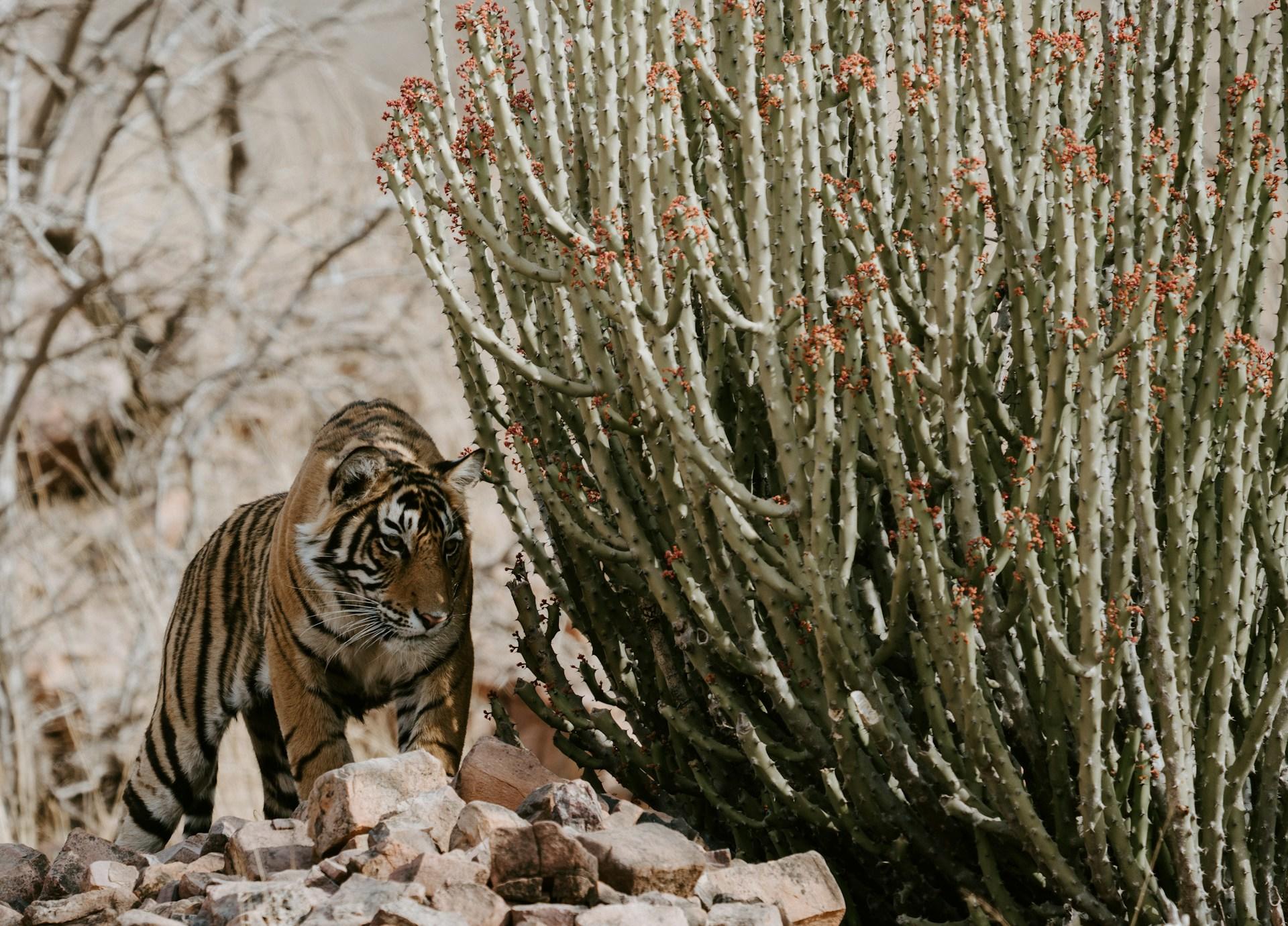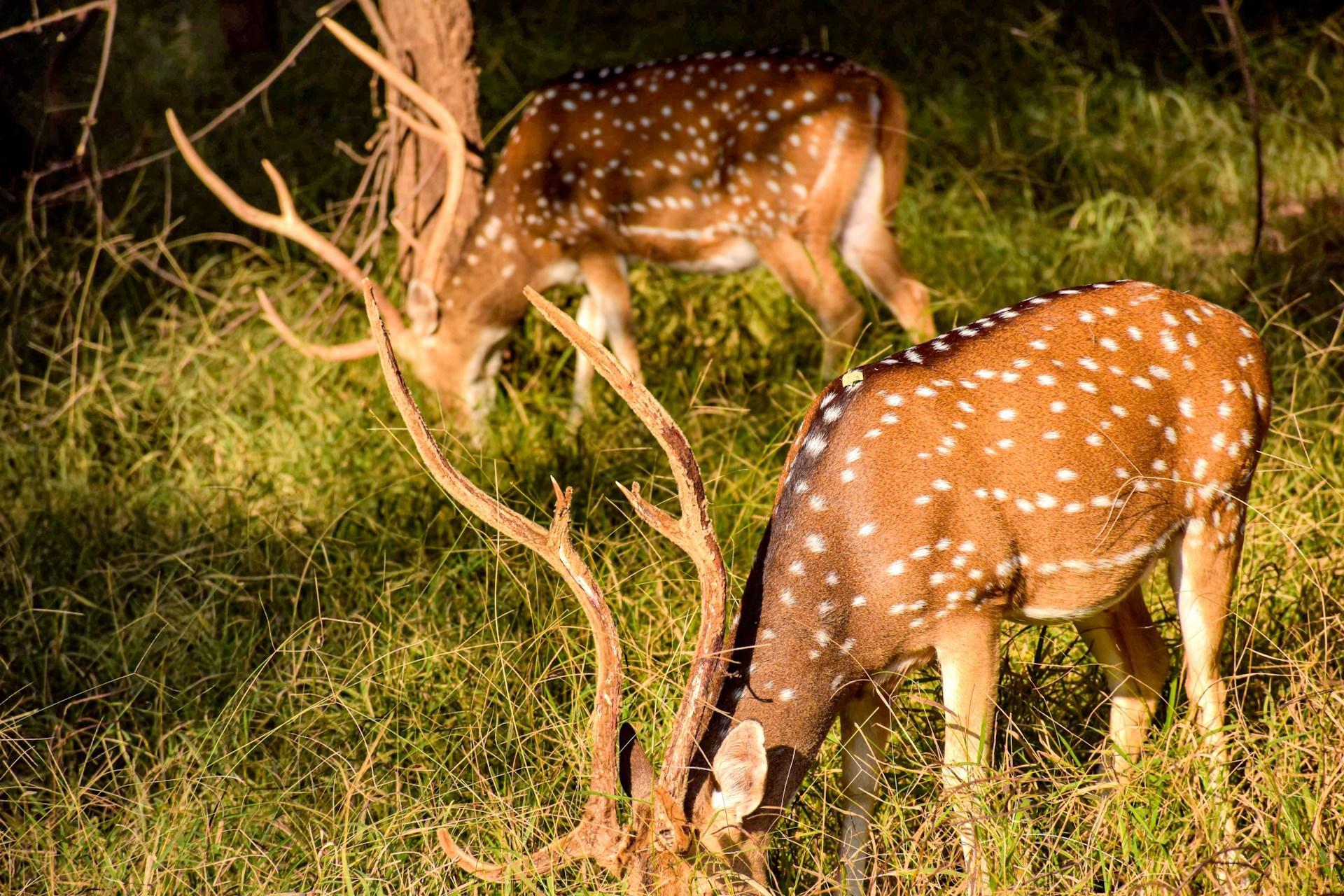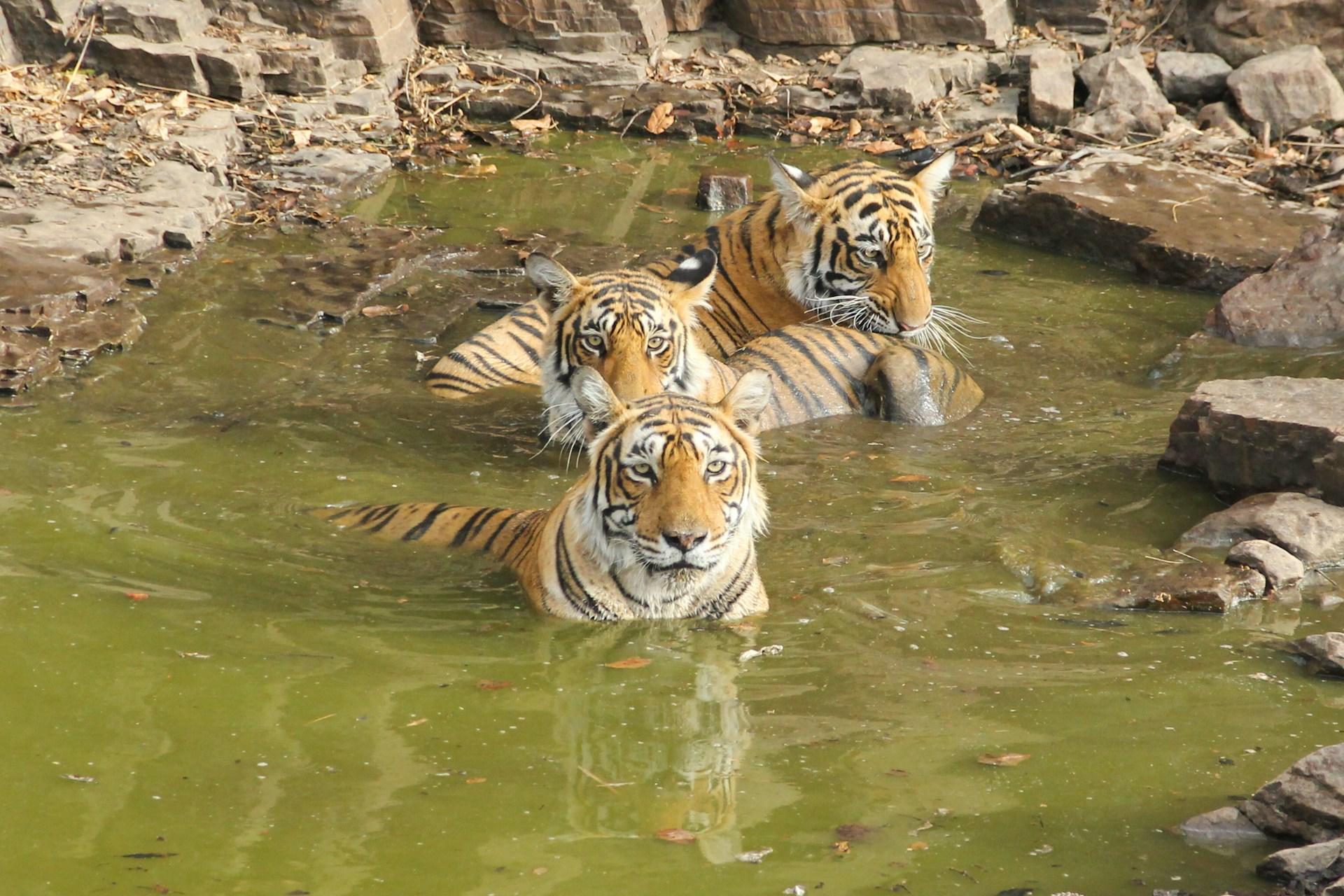Ranthambore National Park, (sometimes spelt 'Ranthambhore') located in Rajasthan, is one of the most renowned wildlife sanctuaries in the world because of its thriving population of wild Bengal tigers. It’s a popular destination for wildlife enthusiasts and photographers hoping to catch a peek at the elusive big cat.
Taking a safari trip through Ranthambore National Park is an exhilarating experience that allows visitors to explore the diverse flora and fauna of this incredible diverse set of ecosystems. There are more than just tigers to be found in the National Park!

Where Is Ranthambore National Park?
Ranthambore National Park is located in the Sawai Madhopur district of southeastern Rajasthan, about 130 km from Jaipur.
It’s named after the historic Ranthambore Fort, which was built around the 10th century BCE and was named a UNESCO World Heritage Site in 2013.
Before Ranthambore was a national park, it was the 282 sq km (109 sq mi) large Sawai Madhopur Game Sanctuary established in 1955, where people would go to hunt the tigers.
In 1973, the Indian government declared the start of Project Tiger, and the park was converted into a Tiger Reserve. It was declared Ranthambore National Park on 1 November 1980. In 1984, the adjacent forests were also declared as sanctuaries, namely the Sawai Man Singh Sanctuary and Keladevi Sanctuary. They were absorbed into Ranthambore In 1992, and now the park is 1,334 sq km (515 sw mi) large.
Facts About Ranthambore National Park
Ranthambore National Park is full of a diverse array of plants and animals, opportunities for adventure, and ancient as well as modern history.
Amazing Bengal Tigers
The highlight of the Ranthambore National Park Safari is the opportunity to spot Bengal tigers in their natural habitat. The park has a well-established tiger conservation program since becoming a designated tiger reserve under Project Tiger in 1973, and the chances of encountering these magnificent cats are relatively high. When the park began, around 46 tigers were living in the park, and now Ranthambore is home to about 80 of the big cats.
The excitement of witnessing a tiger in the wild is unparalleled and makes the safari a truly memorable experience.
Every tiger in the reserve is given an ID number, and most have common names as well. One of the most famous tigresses ever in Ranthambore was known as Machali (T-16), who loved to pose for tourists. She was even featured in a movie “The World’s Most Famous Tiger” and won a National Award! She passed away on 18th August 2016 at the age of 20, which is about the maximum amount of time a tiger can live. Her descendants are much less social, but they are still carrying her bloodline in Ranthambore.
While Bengal tigers are typically reclusive, shy, solitary creatures, since there are so many of them living in Ranthambore, and they must come out to the watering holes to drink, it’s very possible to see these amazing wild cats while exploring the park.
One problem the park faces is that tigers require huge swaths of land as part of their territory, and every time a tiger grows up from cub to roaming adult, it needs to be relocated to another park, or else Ranthambore will be too densely populated. Sometimes these tigers are tranquilized and shipped to a new park, and sometimes the tigers wander away on their own outside of the protective boundaries of the park. A possible solution is the creation of tiger corridors between Ranthambore and two other National Parks in the region, allowing the tigers to travel on their own to new territories.
Project Tiger
Project Tiger was created in 1972 after it was discovered that only about 1,827 Bengal tigers were remaining in India. Their numbers had plummeted due to overhunting, poaching, and habitat loss. The tigers were killed even more when, due to that habitat loss, they would hunt livestock animals, causing the villagers and farmers to kill tigers to protect their assets and their villages.
To help conservation efforts for these magnificent creatures, Project Tiger aims to reduce and reverse habitat loss for the tigers, thereby allowing them to naturally replenish their population. Tigers can be aggressive towards humans, so Ranthambore National Park works by being a remote area away from society, keeping the tigers well away from villages and livestock, where they might be tempted to hunt farm animals and possibly even people.
However, poaching remains a problem, even in Ranthambore National Park. At first, local villagers known as the Mogya tribe, were poaching the tigers to make a living selling the pelts and claws. Tiger Watch, an NGO dedicated to wildlife conservation, made an effort to get to know the Mogya tribe and provide them with other means of living so they wouldn’t need to poach tigers anymore. Now, many of the former poachers work for Tiger Watch, keeping the tigers safe and acting as tour guides. Others have different livelihoods, like crafting.
Other poachers are deterred by regular patrolling and surveillance, intelligence gathering, and strict law enforcement. Still, poachers do find ways to kill tigers from time to time.

A Historic Site
The ruins of Ranthambore Fort now serve as an interesting look into history and a sturdy shelter for the animals. As mentioned, the fort is a UNESCO World Heritage Site, as was originally built around the 8th - 10th century BCE by one of the rulers of the Chauhans.
It features many temples, tanks, massive gates, huge walls, and even a mosque. The notable architectural features include Toran Dwar, Mahadeo Chhatri and Sametonki Haveli.
Diverse Ecosystems
While the area is generally desert-like, it’s also home to wetlands, rivers, and lakes that are replenished during the wet season.
The forest portion is known as a dry deciduous forest, meaning that it undergoes drying in the summers and the trees lose their leaves to conserve water. In the winter, when there is sufficient rain, the trees and other plants flourish.
In between, there are areas of grasslands, featuring mostly grasses of varying heights and shrubs. There are many lakes of varying sizes interspersed throughout the park, the most notable are Padam Talao, Malik Talao, and Raj Bagh Talao.
The entire park is located within the ravines and hills of the Aravalli Range, which is one of the oldest mountain ranges in the world.

Other Fauna and Flora
In addition to Bengal tigers, within Ranthambore National Park, you can find about 40 species of mammals, 35 species of reptiles and 320 species of birds. There are several other types of wildcats living in the park as well!
Some of the animals coexisting with the Royal Bengal Tigers are:
- Indian leopard
- caracal
- jungle cat
- rusty-spotted cat
- nilgai
- blackbuck
- chinkara
- chousingha
- wild boar
- chital
- sambar
- Indian muntjac
- striped hyena
- dhole
- Indian wolf
- Indian jackal
- leopard cat
- Bengal fox
- Asian palm civet
- Indian grey mongoose
- ruddy mongoose
- long-eared hedgehog
- Northern palm squirrel
- Indian porcupine
- Indian hare
- lesser bandicoot rat
- honey badger
- Indian flying fox
- greater false vampire bat
- Indian gerbil
- Indian pangolin
- sloth bear
- Southern plains grey langur
- rhesus macaque
- mugger crocodile
- Snub-nosed marsh crocodile
- desert monitor lizard
- banded kraits
- Indian chameleon
- Ganga Soft-Shelled Turtles
- Indian Pythons
- North Indian Flap Shelled Turtles
- Tortoises
- Rat Snakes
- Russel’s Vipers
- Saw-scaled Vipers
Furthermore, there are about 300 different species of plants in Ranthambore, most notably the Dhok tree, pipal, neem, mango, tamarind, jamun ber, and chhila.
Ranthambore is home to one of the largest Banyan trees in India.
Best Time To Visit Ranthambore National Park
The best time to visit the park to see tigers is during the dry season, from April to June. But, you can visit the park at any time of year and enjoy its amazing scenery and abundance of other animals. In the winter, from October to March, the climate is much milder, but the tigers may be less visible since there are more water sources besides the watering holes to visit. Also, note that safari zones 1-5 are closed in the winter due to the rainy weather.
Safari in Ranthambore
There are 10 zones within Ranthambore for tourists to visit on safari.
You can choose which zones you’d like to visit based on what you want to see. For example, if you want to see tigers, you will likely want to book for zones 1-5. Each zone covers a different section of the park and has limited availability to put less stress on the animals and the environment.
Zones 1-5 were the first to be established, but as popularity in the park grew, zones 6-10 were added so more tours could be conducted with minimal impact on the park.
Visitors can select either viewing Zones 1 to 7 or Zones 8 to 10 on one trip.
| Zone | Notable Sights |
|---|---|
| 1 (Entry through Singh Dwar to zones 1-5) | Home to several tigers and tigresses |
| 2 | Features a watering hole, offering a great opportunity to see several different tigers and even leopards |
| 3 | Many lookouts but less tiger activity |
| 4 | Many tigers live in this zone, and the famous tigress Machli used to live here |
| 5 | Shares many lookout sites with zone 4, so you may see many tigers |
| 6 (Kundal) | This zone has more grasslands, so while you may see some of the resident tigers, you are more likely to see the other wildlife, or even stray cattle from a nearby village |
| 7 (Chidikho) | This smaller zone has some tigers but fewer lookout points to see them |
| 8 (Balas) | Only two tigers are frequently viewed here |
| 9 (Kuwal ji) | This site is 45 minutes away from the Reserve and is home to many different animals as well as an aggressive male tiger (Fateh) who has been known to kill sloth bears and chase forest department vehicles! Beware! |
| 10 (Aantri) | You can see many birds and some tigers |

How to Get to Ranthambore National Park
By Air: The nearest airport is Sanganer Airport in Jaipur which is 180 km away. There are buses available between the airport and the park.
By Rail: The nearest railway station is Sawai Madhopur Railway which is only 11 km away. It is connected to the park by bus, or you could take a taxi.
By Road: Ranthambore is well-connected to the nearby major cities by road, making it easy to use a bus, car, or taxi to reach the park.
Where to Stay: Resorts Near Ranthambore National Park
Since Ranthambore National Park is extremely popular, there are a variety of resorts and hotels to choose from nearby for any budget.
Check out these stays for your tiger retreat in Ranthambore!
- Ranthambore Siddhi Vinayak
- Ranthambore Bagh Villa
- Jungle Cave Resort Ranthambore
- Anuraga Palace Luxury Resprt & Spa
- Omak Tiger Seven Boutique Hotel
- Tiger Moon Resort
- The Baagh Ananta Elite
- The Fern Ranthambore Forest Resort Sawai Madhopur
- Treehouse The Pugmark (A Wildlife Resort)
Visiting Ranthambore National Park is sure to be a thrilling and incredible adventure!















